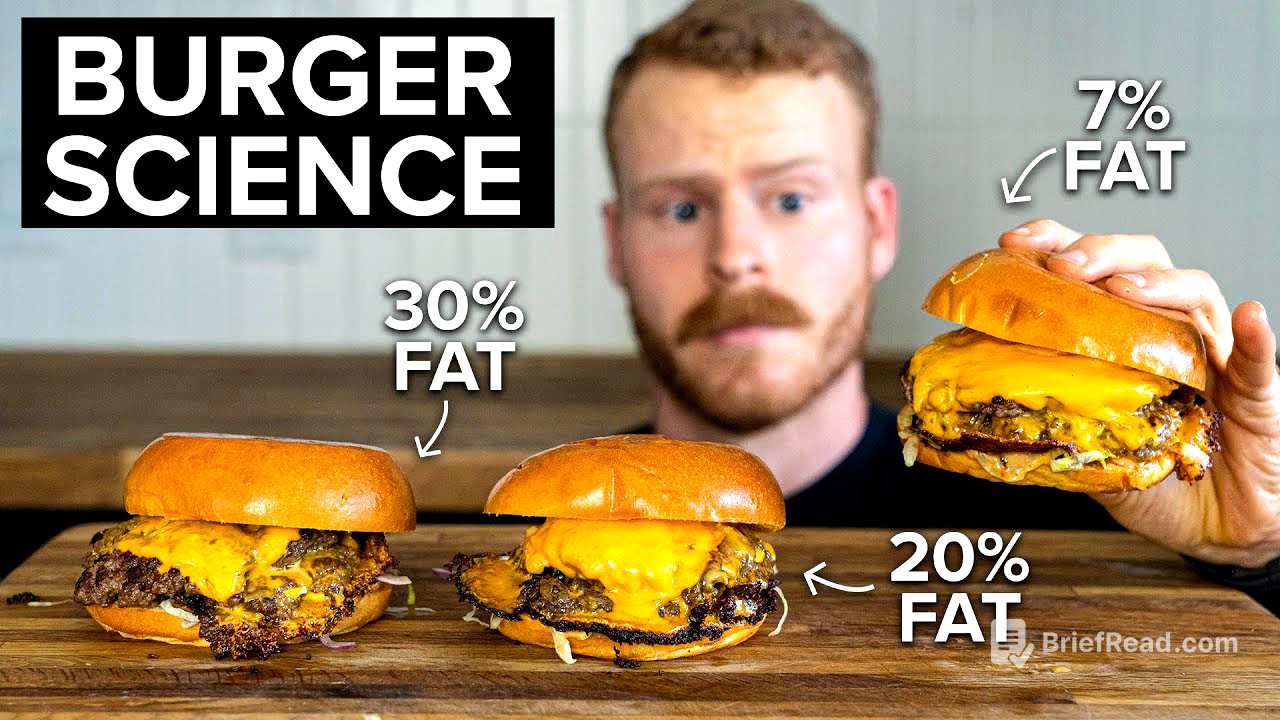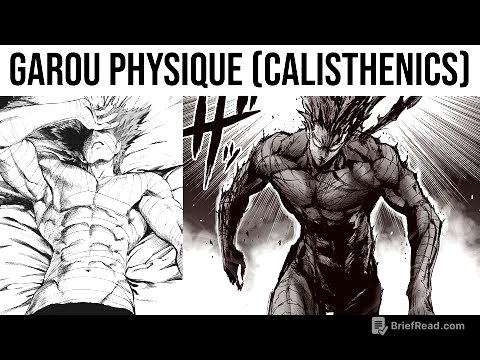TLDR;
This video explores the fundamentals of making the perfect burger at home through food science and experiments, focusing on the impact of fat content in ground beef. It covers topics such as the role of fat in flavor and texture, the importance of burger juices, and how different fat ratios affect browning and crust formation. The key takeaways are that beef fat significantly contributes to flavor and texture, burger juices enhance mouthfeel, and achieving a good crust is crucial for an enjoyable burger experience.
- Beef fat is essential for flavor and texture.
- Burger juices (fat and water) enhance mouthfeel.
- Crust formation is crucial for a good burger.
Intro [0:00]
The video introduces the concept of understanding the fundamentals of making the perfect burger at home through basic food science rather than presenting a specific recipe. The video aims to explore the science behind burgers, addressing questions like the meaning of "fat is flavor," achieving optimal beef flavor, the importance of burger juice lubrication, the appeal of crispy burgers, the impact of different ground beef types, and whether a chicken burger can taste beefier than a beef burger. The focus is on the big picture fundamentals relevant to home cooks, applicable to any burger preparation.
The pathway to the Perfect Burger [0:33]
The video outlines five experiments and taste tests designed to explain the science behind making great burgers. The experiments will cover topics such as the meaning of "fat is flavor", achieving beef flavor, the importance of burger juice lubrication, the appeal of crispy burgers, the impact of different ground beef types on browning, and the possibility of making a chicken burger taste beefier than a beef burger. The video focuses on core ingredients, particularly ground beef.
What is ground beef made of? [1:50]
The video specifies the three ground beef mixes used for the experiments: 93/7, 80/20, and 70/30. These blends are commonly available in grocery stores and butcher shops and are evenly spaced across the fat content spectrum to highlight clear differences in the experiments and explain the food science. The differences in the raw appearance of these mixes, particularly the amount of white beef fat interspersed with the lean meat, significantly affect the burger's outcome. Ground meat consists of lean meat and fat, with the fat content being a key factor.
Experiment 1 - Lean Meat vs Beef Fat [3:31]
The first experiment compares the cooking behavior of lean meat (flank steak) and pure beef fat. Fifteen grams of each are cooked separately on a griddle to observe their differences. The experiment reveals three key observations: liquid release, browning, and beefy flavor. The fat melts and pools, while the lean meat releases water. The fat shallow fries itself, leading to crispy brown bits, while the lean meat steams and turns gray. The fat emits a beefier smell compared to the lean meat.
What does 'fat is flavor' mean? [6:40]
The video addresses the phrase "fat is flavor," explaining that the meaty, beefy flavor comes from the beef fat, not just the lean beef. Filet mignon, while tender, lacks beefy flavor compared to a ribeye due to the higher intramuscular fat in the ribeye. The video explores whether adding beef fat to ground chicken can make it taste beefier than a lean beef burger.
Experiment 2 - Chicken Burger with Beef Fat [7:29]
In the second experiment, a 93/7 ground beef patty is compared to a chicken burger made with 135 grams of ground chicken breast mixed with 35 grams of beef fat (creating an 80/20 chicken-beef fat mix). The burgers are cooked and assembled with simple toppings. A blind taste test is conducted with the presenter's brother to determine which burger is juicier and tastes beefier. The chicken burger was juicier and had a better crust, while the beef burger tasted more like beef but was drier.
What makes up 'beefy' flavor? [10:30]
The experiment reveals that beef fat is important but not the only factor for achieving beef flavor. The combination of beef fat, lean beef flavor, and the Maillard reaction (browning) is essential. More beef fat generally means more beef flavor, but there's a point where it can become too greasy.
How does fat affect burger texture? [11:24]
The video transitions to discussing the impact of fat on burger texture, focusing on juiciness and crust formation. Two burger styles are tested: a large pub-style burger and a smash burger. The video also mentions a griddle press set from Made In, used to increase contact points for better browning.
What are burger juices? [12:51]
The video defines burger juices as a combination of melted fat from the ground beef and water released from the lean meat as it cooks. The goal is to retain as much of these juices as possible by avoiding overcooking and adding more fat to the burger mix.
Experiment 3 - Lubrication Test [13:40]
In the lubrication test, 150-gram patties from each ground beef mix (93/7, 80/20, and 70/30) are cooked to medium. The burgers are weighed after cooking, and then squeezed between deli containers to simulate eating, with the released juices also weighed. The 93/7 mix retained the most weight but released the least juice, while the 70/30 mix released the most juice. Burger juices are compared to a salad vinaigrette, where fat and liquid enhance mouthfeel and impart flavor.
Why do we love burger juices? [15:05]
Burger juices lubricate the tongue, providing a glossy, unctuous mouthfeel. The ratios of fat to water in the juices vary, with 80/20 beef juice having more fat than 93/7. The fat enhances and concentrates the beefy flavor and lubricates toppings, sauces, and cheeses.
Experiment 4 - Seared vs Steamed Burger [16:33]
The video highlights the importance of crust formation, comparing a burger cooked in a pan to one poached in water. The poached burger doesn't brown because the Maillard reaction requires temperatures above 300 degrees Fahrenheit. The pan-cooked burger achieves a nice crust due to the melting beef fat creating a layer of thermal conductivity.
Experiment 5 - Crust Formation [17:51]
In the crust formation test, smash burgers are made from each ground beef mix (93/7, 80/20, and 70/30). Eighty-five gram balls of each mix are smashed onto a hot griddle with a press and cooked for 60 seconds per side. The biggest difference in crust formation is between the 93/7 and 80/20 mixes, with the higher fat content leading to better crust formation and a more noticeable textural contrast.
Final Taste Test - 93/7 vs 80/20 vs 70/30 [18:37]
For the final taste test, three identically sized double smash burgers are made with the three ground beef mixes (93/7, 80/20, and 70/30) and topped with burger sauce, lettuce, red onion, and cheese. The biggest step up in taste and crust was with the 70/30 burger. The differences between the 93/7 and 80/20 burgers were not as significant as expected, especially with the addition of toppings and sauces.
Conclusions [21:05]
The video concludes that higher fat content in ground beef leads to noticeable benefits in flavor and crust formation, with 80/20 being perfectly acceptable. Using 93/7 beef with the smash burger technique is a good option for those watching their waistline, especially when adding sauces and cheeses to enhance juiciness. The observations and food science principles discussed in the video can help viewers make better burgers.









